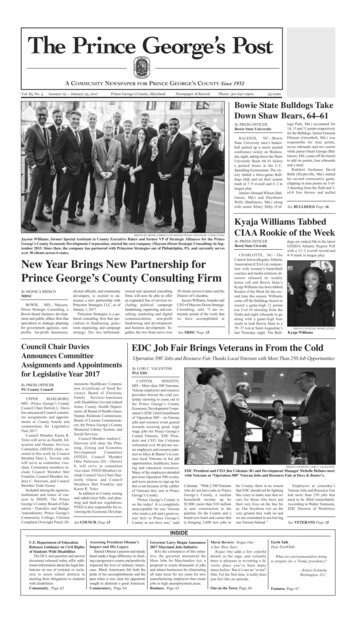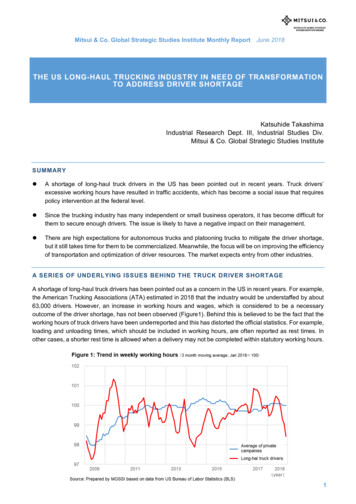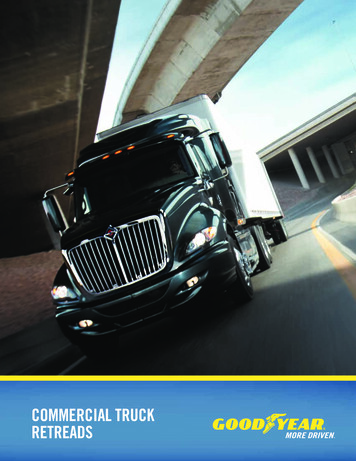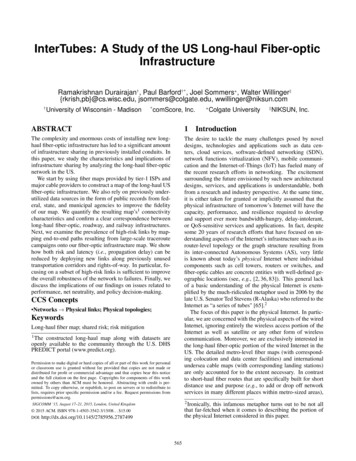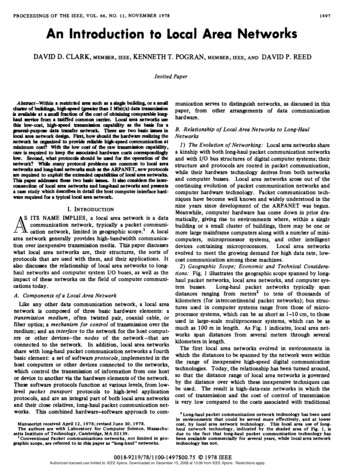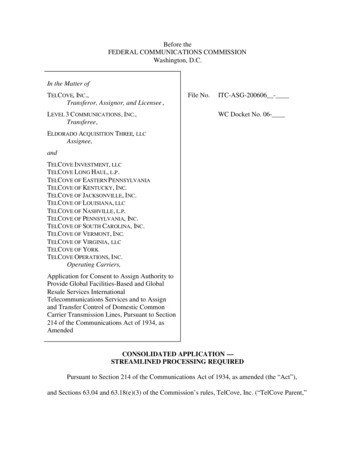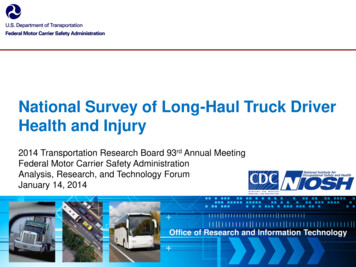
Transcription
National Survey of Long-Haul Truck DriverHealth and Injury2014 Transportation Research Board 93rd Annual MeetingFederal Motor Carrier Safety AdministrationAnalysis, Research, and Technology ForumJanuary 14, 2014Office of Research and Information Technology
OutlineI.Survey Objectives and DevelopmentII. Survey ConductIII. Some ResultsIV. Future DirectionsOffice of Research and Information Technology1
NIOSH Transport Strategic Goal #3Improve health and reduce premature mortality throughworkplace programs and practices that: Enable workers to engage in healthy behaviors. Reduce work-related physiological and psychologicalstressors. Improve healthcare utilization.Office of Research and Information Technology2
Survey Objectives Provide baseline data about long-haul truck drivers’health and safety, including prevalence of selectedhealth conditions and risk factors. Describe prevalence of risk factors associated withpoor health and safety outcomes within the long-haultruck driver population. Provide information to drivers, the trucking industry,and the transportation research community that willguide health and safety promotion, interventions, andfuture research needs.Office of Research and Information Technology3
Survey Plan Intercept study of long-haul truck drivers stopping attruck stops. Nationally representative 3 stage probability sample. Truck driver eligibility: Truck driving is the main occupation. Drives a truck with three or more axles (a heavytruck). Has driven a heavy truck 12 months or longer. Takes at least one mandatory 10-hour rest periodaway from home during each delivery run.Office of Research and Information Technology4
Survey Interview Face-to-face interview by trained interviewers. Data collection at 32 truck stops in 20 States.Conducted October through December 2010. 1,670 drivers interviewed. 1,265 completed the full survey and 405completed only a non-respondent questionnaire.Office of Research and Information Technology5
Statistical Analysis of Survey Data Descriptive characteristics and prevalence estimatesfor health conditions and risk factors. Prevalence was sex- and age-adjusted to the 2010 U.S.employed population. Results were compared to thosefrom working adults included in the 2010 NationalHealth Interview Survey (NHIS). The NHIS is a national household, multistageprobability sample survey conducted annually by theNational Center for Health Statistics (NCHS).Office of Research and Information Technology6
Truck Stop LocationsOffice of Research and Information Technology7
SOME PRELIMINARYRESULTSOffice of Research and Information Technology8
Findings of ConcernCompared to the national working population, we found thatfor long-haul truck drivers: Prevalence of obesity is twice as high (69% vs. 31%). Prevalence of morbid obesity is twice as high (17% vs. 7%). Prevalence of current cigarette smoking is more than double(51% vs. 19%). Prevalence of self-reported diabetes is elevated (14% vs. 7%). Over twice as many drivers are not covered by healthinsurance or a health care plan (38% vs. 17%). A lower percentage of drivers perceived their health status asexcellent, very good, or good (84% vs. 94%).Office of Research and Information Technology9
Self-Reported Risk FactorsRisk Factor ReportedHypertensionHigh cholesterol BMI: Normal (20 BMI 25) BMI: Overweight (25 BMI 30) BMI: Obese (BMI 30) BMI: Morbid obesity (BMI 40)No physical activity for 30 minutesCurrent cigarette smoker Average: 6 hours or less sleep in 24 hours Average: 6–8 hours of sleep in 24 hours Average: More than 8 hours of sleep in 24 hoursTruck Driver 2010 NHISNationalNationalPrevalence* 64%22%*5%* Estimates are weighted and sex- and age-adjusted to 2010 population† P 0.01Office of Research and Information Technology10
Hypertension, Smoking, and ObesityNumber of Risk Factors Reported(Hypertension, Smoking, Obesity)1 or more risk factorAll 3 risk factorsTruck DriverNationalPrevalence*88%9%2010 NHISNationalPrevalence*54%2%* Estimates are weighted and sex- and age-adjusted to 2010 working populationOffice of Research and Information Technology11
Self-Reported Health ConditionsSelf-Reported Health ConditionHeart DiseaseDiabetesTruck DriverNationalPrevalence*2010 NHISNationalPrevalence4%†7%14%†7%* Estimates are weighted and sex- and age-adjusted to 2010 population† P 0.01Office of Research and Information Technology12
Self-Reported Health Care CoverageNationalNationalPrevalence* Prevalence*per 2010per TruckNHISDriversPerceived Health: Excellent, Very Good, or Good84%†94%Perceived Health: Fair or Poor16%†6%Not Covered by Health Insurance or Health Care Plan38%†17%Delayed/did not receive needed health care in 12 months18%10%Did not receive flu shot in 12 months80%†67%Self-Report Health Care Coverage* Estimates are weighted and sex- and age-adjusted to 2010 population† P 0.01Office of Research and Information Technology13
Sleepiness Disturbance (Preliminary)Screening IndexEpworth Sleepiness Scale*Probability of Respiratory Disturbance†Mean Index Value Drivers AboveIndicating ApneaMean Value90.4715%59%* 1990-97 MW Johns. Used under license.† Maislin et al. [1995], Pack et al. [2001].Office of Research and Information Technology14
Highway Safety OutcomesOccurrenceNear miss in the past 7 days:At least one near missNear miss in the past 7 days:Two or more near missesNodding off/falling asleep/drowsiness:Drivers who have nodded off or fallen asleep while drivingNodding off/falling asleep/drowsiness:Drivers feeling very drowsy almost every day drivingWeightedNationalEstimate*24%12%34%7%* Weighted national estimates using 1,265 survey responses.Office of Research and Information Technology15
Work and Driving PracticesDescriptionMean number of hours worked in the last 7 daysDriving practice on trip:Driving aloneDriving practice on trip:Driving with othersDriving with second jobDrivers with union membership0 days slept at home in the last 30 days1-6 days slept at home in the last 30 days7 or more days slept at home in the last 30 * Weighted national estimates using 1,265 survey responses.Office of Research and Information Technology16
Strengths and LimitationsStrengths: Nationally representative population-based sample.National prevalence estimates of illness and injury.Methodology designed for hard-to-reach, mobile workers.Standardized questions used.Non-response bias assessed.Limitations: Cross-sectional design. Self-reported data is subject to recall and interviewerbias.Office of Research and Information Technology17
Project Products Six descriptive articles in process: Survey approach, conduct, and selected findings. Health behaviors. Crashes and injuries, safety, and training. Truck stop amenities and food options. Truck driver working environment/work history. Sleep disorders/fatigue and risk factors. Website. Dissemination of findings. Public use data file. Other suggestions?Office of Research and Information Technology18
Continuing ResearchOther research suggested by survey results: Dissemination of safety and health information totruck drivers and managers. Longitudinal studies of truck drivers. Workers compensation analyses. Owner-operators as a group. Sleep apnea, fatigue. Age and driving. Public health burden.Office of Research and Information Technology19
NIOSH Transportation Web Pages NIOSH Science Blog:www.cdc.gov/niosh/blog/nsb111907 truck.html Transportation, Warehousing, and UtilitiesSector Program Page:www.cdc.gov/niosh/programs/twu/ Motor vehicle safety page:www.cdc.gov/niosh/topics/motorvehicle/ Twitter account:@NIOSHTransportOffice of Research and Information Technology20
AcknowledgementsThis work was supported by the National Institute forOccupational Safety and Health with partial funding from theFederal Motor Carrier Safety Administration, U.S.Department of Transportation.Albert Alvarez, Rebecca Brewster, Dale Belman, MichaelBelzer, LaMont Byrd, Gerald Donaldson, Eric Garshick,Gerald Krueger, Scott Madar, Anne McCartt, StephaniePratt, Thomas Weakley, Martin Walker, Ann Williamson, andEric Wood each provided helpful comments and/or guidancein development of our survey and questionnaire.Office of Research and Information Technology21
Contact InformationKarl SieberNIOSHwsieber@cdc.gov(513) 841-4231The findings and conclusions in this presentation are those of theauthor and do not necessarily represent the views of the NationalInstitute for Occupational Safety and Health.Office of Research and Information Technology22
APPENDIXOffice of Research and Information Technology23
Demographics (1)DescriptionMaleFemaleAge Range: 20-29 yearsAge Range: 30-39 yearsAge Range: 40-49 yearsAge Range: 50-59 yearsAge Range: 60-69 yearsAge Range: 70-80 yearsWeighted National Estimate*94%6%5%17%33%29%15%1%* Weighted national estimates using 1,265 survey responses.Office of Research and Information Technology24
Demographics (2)DescriptionHispanic or LatinoWhiteAfrican AmericanOther or multiple raceUnknownWeighted National Estimate*9%74%17%7%3%* Weighted national estimates using 1,265 survey responses.Office of Research and Information Technology25
Employment (1)DescriptionMean number of years as a long-haul truck driverEmployment: Company EmployeeEmployment: Owner-operatorType of company working or contractor for:For-hireType of company working or contractor for:Private carriageType of company working or contractor for:Both for-hire and privateType of company working or contractor for:Don’t 5%35%90%8%1%0.5%* Weighted national estimates using 1,265 survey responses.Office of Research and Information Technology26
Employment (2)DescriptionType of freight shipment on current trip:Less than truckload freightType of freight shipment on current trip:Truckload freightType of freight shipment on current trip:Unknown/refused/missingMethods of work compensation: By-the-mileMethods of work compensation: Percentage of revenueMethods of work compensation: By-the-loadMethods of work compensation: By-the-hourMethods of work compensation: SalariedOffice of Research and Information 0%3%1%27
Highway Safety OutcomesDescriptionEver had DOT-reportable truck crashes:At least one DOT reportable crashEver had DOT-reportable truck crashes:Two or more DOT reportable crashesTruck crash injury:Injured in most recent crashMoving violations in the past 12 months:At least one moving violation in the last 12 monthsMoving violations in the past 12 months:At least two or more moving violations in the last 12 monthsOffice of Research and Information 8
Intercept study of long-haul truck drivers stopping at truck stops. Nationally representative 3 stage probability sample. Truck driver eligibility: Truck driving is the main occupation. Drives a truck with three or more axles (a heavy truck). Has driven a heavy truck 12 months or longer. Takes at least one mandatory 10-hour rest period

